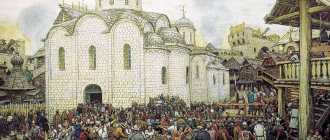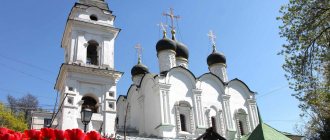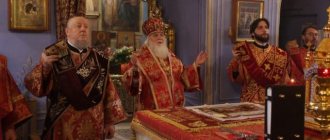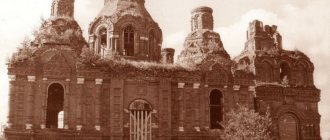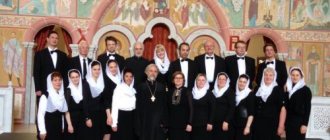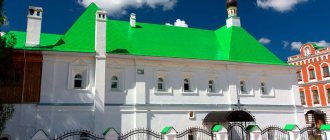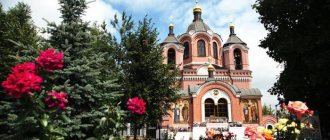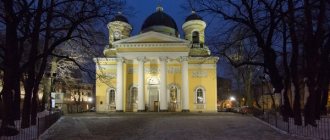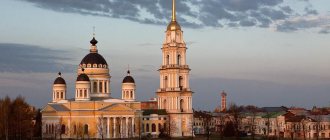| Moscow Transfiguration Church on Preobrazhenskaya Square on the day of consecration, May 8, 2015. Photo by Evgeny Ermakov from the site sobory.ru |
Moscow Church in honor of the Transfiguration of the Lord on Preobrazhenskaya Square, in Preobrazhenskoye,
Moscow Diocese
- Thrones
- Upper Church: Transfiguration of the Lord (main), blgv. book Alexander Nevsky (northern), app. Peter and Paul (southern)
- Lower Temple: ap. Andrew the First-Called with an adult font, St. Nicholas the Wonderworker
| Church of the Transfiguration in Preobrazhenskoye. September 7, 2016 |
The Church of the Transfiguration in the village of Preobrazhenskoye near Moscow was built in 1768 and became the successor to the wooden church of Peter the Great's time. Historically, it was the main temple of the Preobrazhensky Regiment, the first regiment of the Russian guard created by Peter I. Under Soviet rule, the Transfiguration Church remained one of the few operating churches in Moscow and until 1960 served as the cathedral church of Metropolitan Nikolai (Yarushevich) of Krutitsky and Kolomna.
| Moscow Transfiguration Church on Preobrazhenskaya Square |
In 1964, the Transfiguration Church was closed and prepared for demolition under the pretext of creating conditions for the construction of a metro line.
The parishioners of the temple desperately fought for its preservation - they sent letters to the Central Committee of the CPSU and the Moscow Soviet, and even tried to build a living ring around the doomed building. On the night of July 18, 1964, the church was blown up. In the 1990s, the recreated community of the temple installed a wooden cross in the park on the spot where it stood and persistently sought its restoration as a spiritual center and a monument to the military glory of Russia. The project for the restoration of the temple on the preserved foundations was developed by the Preobrazhenskoye Center for Traditional Russian Culture. Every year on August 19 - the day of the patronal feast of the Transfiguration Church - solemn ceremonies are held on Preobrazhenskaya Square near the cross with the removal of a copy of the banner of the Preobrazhensky Guards Regiment and a small military parade.
In the early 2000s, the idea of restoring the temple was supported by His Holiness Patriarch Alexy II of Moscow and All Rus' and Moscow Mayor Yuri Luzhkov, but the final resolution of the issue was delayed for a long time due to the lack of permission from the prefecture of the Eastern Administrative District of Moscow.
On August 19, 2008, plans to restore the temple were announced by the prefect of the eastern district of Moscow, Nikolai Evtikhiev, during the traditional celebration of the Transfiguration of the Lord, held on the site where the temple was previously located. At the beginning of 2010, work began on the restoration of the temple.
On May 8, 2015, Patriarch Kirill of Moscow and All Rus' performed the rite of the great consecration of the Church of the Transfiguration of the Lord on Preobrazhenskaya Square in Moscow and the Divine Liturgy in the newly consecrated church [1].
Modernity
The building was transferred to the Orthodox Church in 1990. In August of the same year, the Church of the Transfiguration of the Lord in Tushino was consecrated by Patriarch Alexy II. Over the next four years, the chapels of St. Nicholas the Wonderworker, St. Sergius of Radonezh and the bell tower were restored and consecrated.
To date, there is a cemetery on the temple grounds, where the remains of people from the graveyard destroyed during the Soviet years and a Sunday school building have been reburied.
The temple servants are active in educational and social activities.
Architecture and interior
Modern restorers have recreated the appearance of the building using old photographs and the remains of surviving architectural elements. The temple building is made of red brick. It has a rectangular shape, elongated from west to east. The main part is crowned with a black onion-shaped head standing on a round drum. It is balanced by the bulbous top of the temple bell tower. The northern and southern aisles of the church are crowned with small gilded heads.
The facades and rounded apse are decorated with mosaic images of the apostles and holy fathers of the church. The icon cases depict the composition “Deesis”.
Interior of the Church of the Transfiguration of the Lord in Tushino
Inside, the walls and columns of the main part of the church are decorated with mosaics made by a group of craftsmen under the leadership of L. D. Tsarev. The large and two small iconostases were made in the ancient Russian manner and painted by icon painter Olga Grigorievna Klodt. The walls of the refectory and both aisles are covered with paintings.
The restrained architecture of the temple is complemented by a beautiful garden, laid out by the priests and parishioners.
Guard Temple
08.05.2015
Konstantin Mikhailov
On the morning of May 8, 2015, on the eve of Victory Day, a large, solemn and touching event took place on Preobrazhenskaya Square in Moscow, which still seems like a miracle. Great Consecration of the Church of the Transfiguration of the Lord and Divine Liturgy. Patriarch Kirill of Moscow and All Rus' served.
The honorary guests of the ceremony were the co-chairman of the Board of Trustees of the Charitable Foundation for the Revival of the Temple Svetlana Medvedeva, the Minister of Culture of Russia Vladimir Medinsky, the Minister of Health of the Russian Federation Veronika Skvortsova, the Chairman of the Central Election Commission Vladimir Churov, the Plenipotentiary Representative of the President of the Russian Federation in the Central Federal District Alexander Beglov, the Deputy Minister of Defense of the Russian Federation Nikolai Pankov, State Duma deputies Vladimir Resin , Sergei Popov, Leonid Slutsky, Moscow Mayor Sergei Sobyanin.
An ancient banner of the Preobrazhensky Regiment was brought specially for the ceremony from the Historical Museum. Preobrazhenskaya Square has not seen such celebrations since 1883.
All this is not accidental. All this was suffered, deserved, done by those who twenty years ago decided for themselves that the unprecedented can happen and the Church of the Transfiguration will exist. And he is. Although I still can’t believe it.
Last preparations. May 7, 2015.
1964-2015
At four o'clock in the morning on July 18, 1964, residents of Preobrazhenskaya Square and the surrounding area were awakened by a terrible roar. They knew that that night they were supposed to blow up the ancient Church of the Transfiguration, which allegedly interfered with the construction of the metro. As eyewitnesses recalled, who, despite the ban, did not move away from the windows, the temple seemed to rise above the ground - and crumble in the air. The next morning, tram passengers were surprised: in the evening there had been a church here, but now it was a pile of ruins.
No one knew then that this was the last explosion of an Orthodox church in Moscow in the 20th century. Half a century and one year later, Moscow regains the Church of the Transfiguration.
Everything has changed around since then: in the 1980s, the last two-story houses on Preobrazhenskaya Square disappeared, the pre-revolutionary Orion cinema did not survive the reconstruction of the 1990s and was replaced by a bank building; on the contrary, first a high-rise residential complex was built, and then a high-rise office complex. And in the midst of all this triumph of development, the time machine started working: a cube-quadrangle, apses, vaults, and a bell tower appeared as if sprouted from the ground. And old photographs of the area suddenly became recognizable. Transfiguration is back. Or is it we, the Preobrazhensky residents (the author is a native of this area), who have returned home?
1962-1964
The July 1964 explosion had a backstory, partly a detective story. According to some priests and parishioners of those years, which is now shared by historians, the true reason for the destruction of the Transfiguration Church was the desire of the authorities to erase from the face of Moscow the memory of Metropolitan Nikolai Yarushevich, a prominent figure in the Russian Orthodox Church of the mid-twentieth century, who was considered the “personal enemy” of the Soviet leader Nikita Khrushchev.
The Church of the Transfiguration was the see of Metropolitan Nicholas, the “Zlatoust of the twentieth century.” In 1943, he participated in the famous meeting of church hierarchs with Stalin, which marked the beginning of the revival of the Church, and in the Khrushchev era he began to openly resist new anti-religious persecutions and the closure of churches. In the church on Preobrazhenka, he criticized the policies of the party and government directly from the pulpit, and recordings of these sermons were distributed by church “samizdat” to other parishes and cities. According to the official version, the reason for the Moscow City Council's decision to demolish the Church of the Transfiguration in 1962 was the construction of a metro line, but the metro tunnel bypassed the foundations of the temple. One of the former metro builders, who led the explosion in 1964, “admitted” to the author in 2004 that the original metro project did not include the demolition of the temple, but in the midst of construction, orders were received “from above” to blow it up under this plausible pretext.
In the July days of 1964, about 300 parishioners of the Church of the Transfiguration, desperately trying to save their temple, surrounded it with a living ring and held the line for several days. They were dispersed by the police and vigilantes.
Divine service in the Church of the Transfiguration. Photo from the 1940s.
Metropolitan Nikolai Yarushevich (right) in the Church of the Transfiguration. Photo from the 1940s.
Transfiguration Church before demolition in July 1964. The fence enclosing the now closed church is visible. Around the temple are believers trying to protect it.
1996-2009
I clearly remember the patronal feast of the non-existent church - Transfiguration Day, August 19, 1996. Not far from Preobrazhenskaya Square, in a cramped room at the Preobrazhenskoye Center for Traditional Russian Culture, several people gathered. Community. Parishioners who still went to that bombed church. Table with apples. Prayer. Quiet conversation. These people rallied around the founder and general director of the Center, architect-restorer Igor Rusakomsky
, dreamed of restoring the temple.
Igor Klimentievich Rusakomsky. August 19, 2009. Preobrazhenskaya Square.
Igor Klimentievich was not just the author of this idea. For many years he was the soul of this enterprise and its main driving force. An agitator, a negotiator, a propagandist, a petitioner, a leader - everything. Fortunately, he was not alone. But without him, nothing would have happened. He did not give up, did not despair, did not give up - even when the dream seemed completely unrealistic. And even if he despaired, he found the strength to continue the fight for the Transfiguration Church. And it turned out that the drop wears away the stone.
Foundation stone for the Transfiguration Church. 1997
It is impossible to tell about everything - there is not enough space. About the endless persuasion of officials, about getting approval for the metro, about supporting the idea of restoring the temple by the late Patriarch Alexy II, about registering an Orthodox parish. About the support of Moskomnaslediye and Moskomarkhitektura from the “Luzhkov” call. On placing the foundations of the temple under state protection as historical and cultural monuments. About the installation of a memorial cross on the square, about organizing annual holidays here on August 19 - with prayer services, military parades, bringing the temple icon from the church in Sokolniki, where it ended up in 1964, about collecting the memories of parishioners, about searching for drawings, old photographs and bits of information in the archives. It was a titanic work that took years. The district authorities have already agreed to recreate the temple, but not on a historical site, but somewhere on the outskirts of the Eastern District. The authorities changed, but were inexorable, parishioners died, but the matter did not move.
Authentic temple icon of the Transfiguration of the Lord on Preobrazhenskaya Square. August 19, 2009. The guards of the Presidential Regiment are on the honor guard.
August 19, 2010. Military parade under the banner of the Preobrazhensky Regiment on Preobrazhenskaya Square.
But I remember the first time I believed that the impossible was possible. This was in the fall of 2007. I was walking somewhere along Preobrazhenka about my business, and from afar I saw Igor Rusakomsky, surrounded by several people, near the cross on the square. They prayed in the drizzling rain. This was not on the day of the ceremony, not in front of a television camera, not for show. And there was strength and truth in this, which no authorities could interfere with.
2009-2015
In 2008, Fr. Vladimir Volgin
, rector of the St. Sophia Church, which is opposite the Kremlin. And he convinced the district authorities not to oppose the historical truth. I once came to Preobrazhenka, traveled with the prefect around the district, examined “alternative” sites, talked, convinced. Convinced.
Priest Vladimir Volgin. Patronal feast day on Preobrazhenskaya Square.
On July 17, 2009, the Moscow government issued a decree on the reconstruction of the Church of the Transfiguration “with full identification and scientific authenticity of the restored architectural forms.”
Then there were archaeological excavations: the foundations of the temple appeared from under the ground, you could go down to the basement, where nothing had changed since that very night of July 18, 1964; an iron barrel lay in the corner, probably knocked over by the blast wave. Then there was a search for money and builders; Initially, it was decided that the church would be restored not with budget money, but with charitable donations. Vladimir Resin, then vice-mayor and now State Duma deputy, provided active assistance
. Since then, he constantly came to the site and held working meetings with visible pleasure.
And then construction finally began, which for a long time could not progress beyond the relocation of the zero-cycle communications. This was another titanic task. It was led by the Board of Trustees of the Charitable Foundation for the Revival of the Church of the Transfiguration of the Lord on Preobrazhenskaya Square.
Spring 2010. Archaeological research of the foundations of the temple.
Transfiguration Church. Summer 2014.
August 19, 2014. The erection of the cross on the Transfiguration Church.
The recreated temple is raised on a small podium; in the ground floor, a precious artifact is preserved and exhibited - the original white stone foundation of the Transfiguration Church of 1768. A memorial exhibition on the history of the temple, the village of Preobrazhensky and the Preobrazhensky Regiment will also be created here. But already now, in the basement of the temple, with the help of ultra-modern museum technology, a multimedia exhibition about the Peter the Great era is being demonstrated. There is also a memorial cross that has stood on the square since 1997.
The original white stone foundation of the Transfiguration Church. 1760s.
An ancient tombstone from the early 18th century, built into the foundation of the temple.
The temple was restored not in its original form, but in the guise in which the explosion found it: according to measurement drawings from 1883 and photographs of the 20th century. The temptation to embellish antiquity was avoided. “No matter what they say,” Igor Rusakomsky emphasized, “that the ancient temple was not artistically perfect enough, “unexpressive,” or “decorative” enough, we will not go against history, we will recreate exactly the image of the temple that has become a shrine for several generations of Orthodox Christians believers." Architect Andrey Obolensky
, the author of the reconstruction project, once said: “Colleagues are perplexed - why is your window half covered by the slope of the aisle roof? Well, how else could I have done it - after all, this is how everything was in 1964, as can be seen in all the photographs.”
Church of the Transfiguration in the 1930s.
Church of the Transfiguration. May 2015.
Externally, the appearance and decor of the temple are reproduced accurately, and placing the building on a podium will allow it not to get lost on the current Preobrazhenskaya Square, surrounded by new buildings. From a symbolic point of view, the podium resembles a pedestal: after all, the new temple is a kind of historical monument. No one is rebuilding the 18th century: the memory of the place is being returned.
At the final stage of work, all funding was assumed by the creator of the Museum of Russian Icons, Mikhail Abramov.
. The iconostasis of the main church and chapels, paintings, interior decoration, bells, memorial plaques, interactive exhibition in the basement - the current Church of the Transfiguration owes this to him. Although Mikhail Yuryevich most likely thinks that he owed it to her.
The temple icon of the Transfiguration of the Lord is genuine, donated to the church in the second half of the 19th century by officers of the Preobrazhensky Regiment, about which engraved inscriptions were preserved on the icon case, after the explosion it was in the Church of the Resurrection in Sokolniki. On May 8, 2015, she returned to her place, to her temple on Preobrazhenskaya Square.
Looking at the revival of the temple, on Preobrazhenka they are already thinking about marking the places of all other former local attractions with memorial signs. In those few years when Peter’s Preobrazhenskoe actually served as the capital of the state, there were two royal palaces, a General Chancellery, a shipyard, and the Preshburg fortress, where “amusing” troops were trained in military affairs. The granite obelisk behind the altar of the recreated temple now marks the site of a small cemetery near the church where soldiers and officers of the Preobrazhensky Regiment were buried; remains and headstones were discovered during the restoration. On May 8, 2015, after the consecration of the church, ceremony participants laid flowers at the monument to the Transfiguration.
April 2015. Temple and obelisk on the site of a former cemetery.
1743-1883
In the 18th century, the Church of the Transfiguration was the main temple of the village of Preobrazhenskoye, the residence of Peter the Great, “the capital of Peter’s transformations.” The original church was built on the territory of the yard of the Preobrazhensky Regiment and actually served as a military temple for the first regiment of the Russian Guard. This tradition was felt and honored by the guard and the imperial court even at the end of the 19th century. In 1883, when the 200th anniversary of the Russian Guard was celebrated, it was in the Transfiguration Church that the solemn ceremony of consecrating the regimental guards banners took place, and the imperial family headed by Tsar Alexander III arrived in Preobrazhenskoye. The Preobrazhensky and Semenovsky regiments of the guard marched in front of the temple that day.
The ceremony of consecrating the banners of the Preobrazhensky and Semenovsky guards regiments at the Transfiguration Church. Lithograph 1883
The wooden building of the temple, which preceded the stone one, was built in 1743 by Sergeant of the Preobrazhensky Regiment Ivan Tretyakov
. His name is now embossed in gold letters on a plaque at the entrance to the recreated temple. The stone church, blown up in 1964, was erected in 1768-1781, and new chapels were added to it in the 19th century.
2004
One day, on August 19, 2004, an elderly, tall, thin man came to the Transfiguration Day celebration on Preobrazhenskaya Square. Without entering into conversations with anyone, he stood at the cross during the service, and then went up to Igor Rusakomsky and handed him a huge old key. The key to the Church of the Transfiguration, which he took on July 17, 1964, on the eve of the explosion, “as a souvenir.” This was the same metro builder who led the explosives. For forty years he kept the key at home, showed it to guests, and then, quite by chance, he learned about people seeking to restore the church. And I decided that the key needed to be returned. Now on Preobrazhenskaya Square, fortunately, there is something to open with this key.
The original key to the bombed Transfiguration Church.
2015
How did it happen that the modest church on Preobrazhenskaya Square ended up on the same level as the Kazan Cathedral and the Cathedral of Christ the Savior? How did it happen that the dream of a group of enthusiasts came true twenty years later? You can list a lot of events, tell who wrote what letters to whom and what resolutions were imposed on them, remember the names of influential people who took part in this work.
May 2015 Iconostasis of the main temple.
April 2015. Paintings of the main temple.
But these will all be reasons that do not explain the root causes. However, if you look at this story from a certain historical perspective, it becomes clear that the image and meaning of the temple in the courtyard of the first regiment of the Russian Guard turned out to be very important for Russia and Moscow in the 2000s. Together with the Transfiguration Church, the Preobrazhensky Regiment, previously the “154th separate commandant’s regiment,” was recreated in the Russian Army. Therefore, the consecration of the church is quite logically timed to coincide with Victory Day. After all, military glory is no longer divided into Soviet and pre-Soviet. This is one big History, and on Preobrazhenskaya Square you can now touch it.
Patriarch Kirill of Moscow and All Russia spoke about this very correctly on May 8 in a speech at the obelisk.
: “How important it is to remember the exploits of previous generations, especially on the eve of the upcoming celebration of the 70th anniversary of the victory in the Great Patriotic War! Indeed, for today’s youth, the generation of winners in the Great Patriotic War is also a long time ago, but there are no time limits when it comes to heroism and feats in the name of the Fatherland. Let the memory of the heroes of the Transfiguration, let the memory of all the soldiers who laid down their lives for their Motherland, let the memory of the heroes of the Great Patriotic War always remain in our hearts. I rejoice at the opportunity today to participate with you in this wonderful event at the walls of the revived military Transfiguration Church in Moscow.”
And if you look at the “small” history of the restoration of the temple, remembering the prayers at the cross in the rain, then you can assume the simplest thing: a man-made miracle happened on Preobrazhenskaya Square. Or a miracle made by hands.
And in fact, when you walk here today, it seems that this church has not disappeared anywhere for half a century. She was here, is and will be. It’s just that, apparently, we, Preobrazhensky residents, had some kind of eclipse.
And now everything is clear.
Prayer at the cross on Preobrazhenskaya Square. 2007
Video afterword
: building a model for recreating the Transfiguration Church based on archaeological research data.
Photo: Alexey Rusakomsky, author, archive of the Transfiguration parish.
Work schedule
Services are held daily.
- on weekdays they hold morning and evening services, which begin at 8 and 17 o'clock, respectively;
- on weekends and days of general church and patronal holidays (Transfiguration of the Lord on August 19, St. Nicholas the Wonderworker on May 22 and December 19, St. Sergius of Radonezh on July 18 and October 8), two morning services are held at 7 and 9.40 am.
Divine Liturgy at the Church of the Transfiguration of the Lord
Sunday School classes are held on Saturdays from 10 a.m. to 2 p.m. and Sundays from 12.30 p.m. to 6 p.m.
The schedule of services at the Church of the Transfiguration of the Lord in Tushino, as well as classes at the Sunday School, the work of the library and various associations is specified on its official website.
You should know: the church website contains rules of conduct when visiting a holy place. You should familiarize yourself with them before coming to the temple. Taking photographs and filming videos on the premises is only possible with the permission of the abbot. Therefore, people who just want to take pictures of beautiful architectural structures are better off doing this from behind the church fence.
Moscowolk
- Created: 05/22/2015 15:29
For the 70th anniversary of Victory in the Great Patriotic War, the Temple was restored on Preobrazhenskaya Square, and a comprehensive improvement of the adjacent square was also completed. During Soviet times, the church was one of the most famous strongholds of Orthodoxy in Moscow. On the night of July 17-18, 1964, the Church of the Transfiguration of the Lord was blown up under the pretext of subway construction. This was the last case of destruction of an active church in Moscow.
The Church of the Transfiguration of the Lord on Preobrazhenskaya Square was founded on the territory of the Regimental Court of the Life Guards Regiment of the Preobrazhensky Regiment (1743-1747). Blown up in 1964 Restored to its original location with the blessing of Patriarch of Moscow and All Rus' Alexei II and by order of the Moscow Government. Consecrated by Patriarch Kirill of Moscow and All Rus' on May 8, 2015.
History: In 1747, a sergeant of the Preobrazhensky regiment acquired the building of an old wooden church next door, in Semenovsky. The log house was transported to Preobrazhenskoye and installed in the regimental yard of the Preobrazhensky Regiment, on the site of the linen temporary church. On July 19, 1747, the church was consecrated in honor of the heavenly patrons of Peter I - the apostles Peter and Paul. The throne in the name of the Transfiguration of the Savior, which later became the main one, was consecrated in 1800.
In 1763, parishioners decided to build a new stone church, and collection of donations began. Construction of a new temple began two years later, next to the old wooden church. By 1768, construction was completed and the temple was operational. In 1781, the chapel of Peter and Paul and the bell tower were added to it. During the Moscow fire of 1812, the church was not damaged, services in it did not stop during the entire stay of the French army in Moscow. Beginning in 1830, with the active participation of the merchant Kotov, who was elected church warden, the temple began to improve and grow rich. In 1856, the Preobrazhensky Regiment donated the icon of the Transfiguration of the Lord to the church. On May 23, 1883, before the celebration of the 200th anniversary of the regiment, Alexander III visited the church. After the emperor’s visit, a second chapel was built in the Transfiguration Church in the name of Alexander Nevsky.
Arrivals have been made for disabled people and parishioners with strollers
Light and spacious inside
A park was created in front of the Temple
There is a monument to the Soldiers of the Preobrazhensky Regiment on the square.
Since the temple is closely connected with the history of the Preobrazhensky Guards Regiment, a monument to the “Preobrazhensky” soldiers and officers who died in the wars for the Fatherland was erected near its walls
Preobrazhensky Life Guards Regiment. The regiment was formed by Tsar Peter I in 1691 from the amusing village of Preobrazhenskoye, from which it received its name.
Benches were installed in the park. In the evenings a lot of young people gather here
The square is surrounded by greenery, many bushes and trees have been planted
Along with the revival of the Temple, residents received a green recreation area
This is how Preobrazhenskaya Square has been transformed (all the stalls have been demolished)
Tweet
Home page
www.moscowalk.ru
Add a comment
